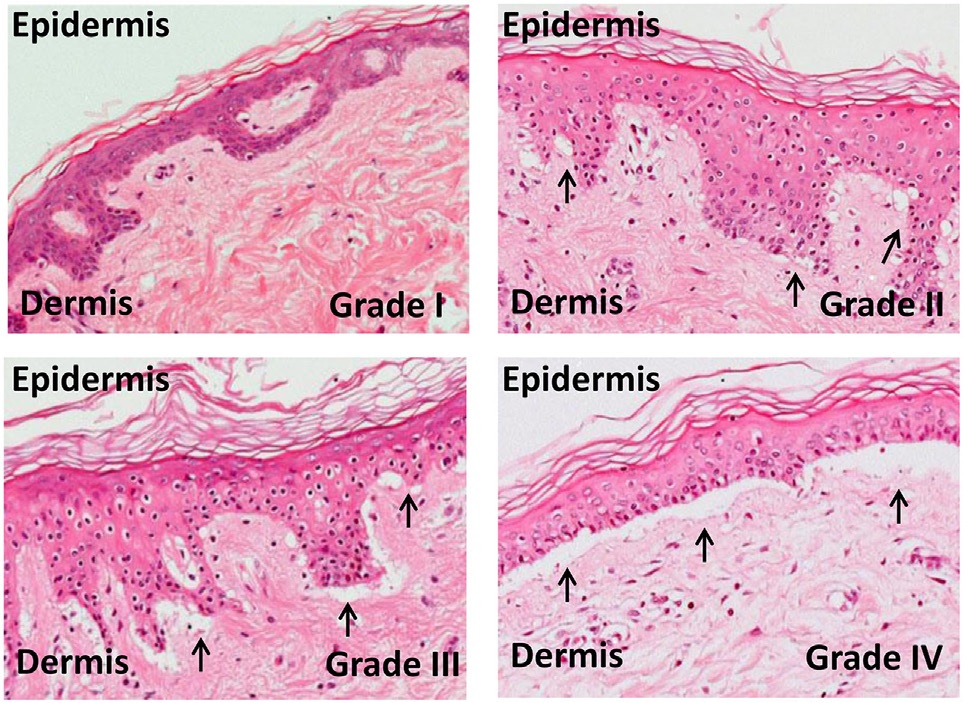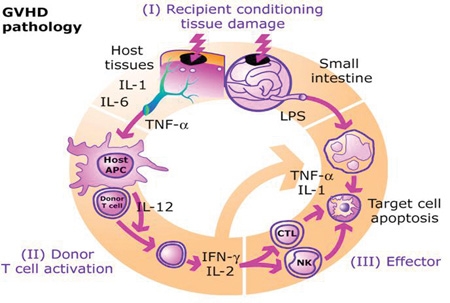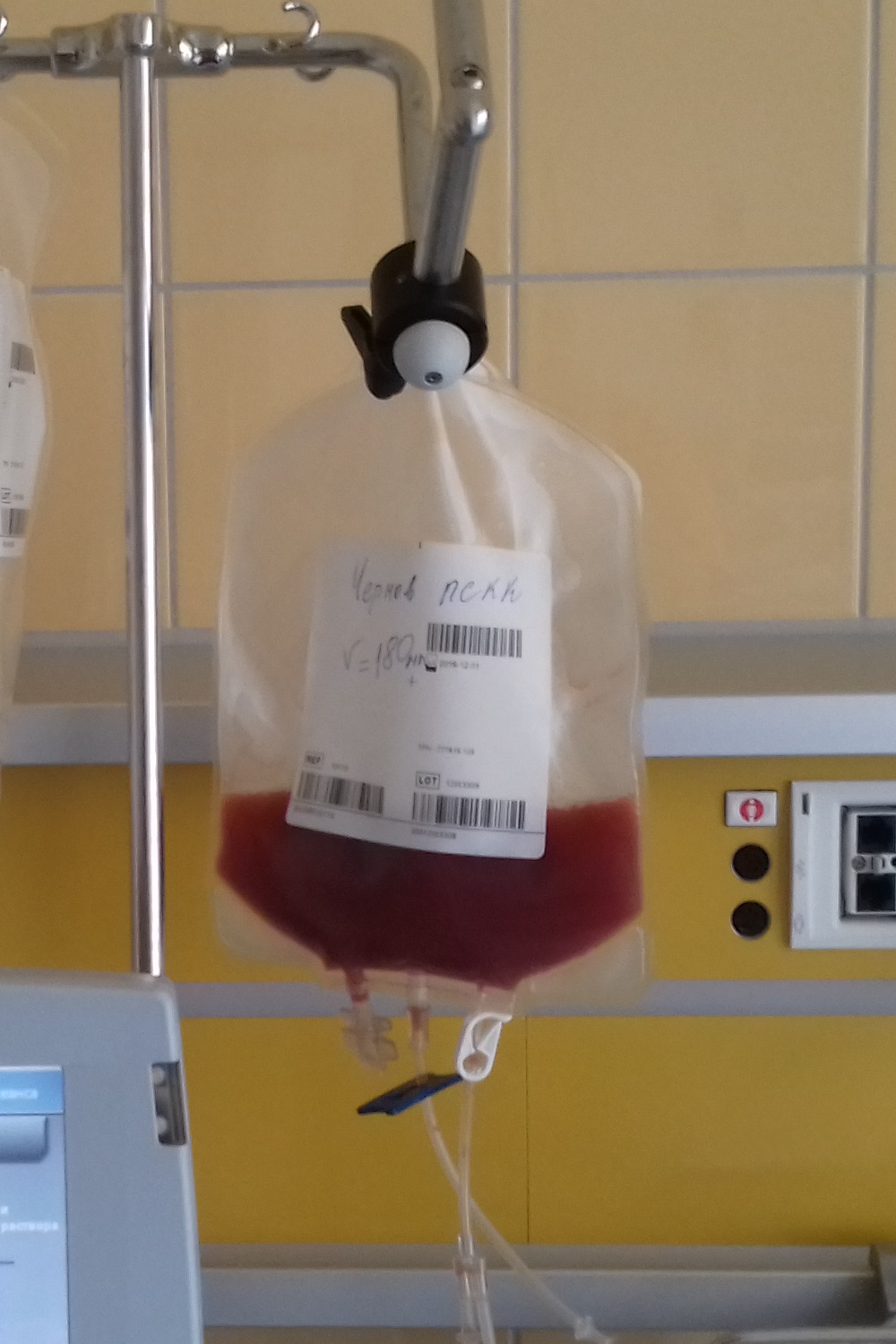|
Graft-versus-tumor Effect
Graft-versus-tumor effect (GvT) appears after allogeneic hematopoietic stem cell transplantation (HSCT). The graft contains donor T cells (T lymphocytes) that can be beneficial for the recipient by eliminating residual malignant cells. GvT might develop after recognizing tumor-specific or recipient-specific alloantigens. It could lead to remission or immune control of hematologic malignancies. This effect applies in myeloma and lymphoid leukemias, lymphoma, multiple myeloma and possibly breast cancer. It is closely linked with graft-versus-host disease (GvHD), as the underlying principle of alloimmunity is the same. CD4+CD25+ regulatory T cells (Treg) can be used to suppress GvHD without loss of beneficial GvT effect. The biology of GvT response is still not fully understood but it is probable that the reaction with polymorphic minor histocompatibility antigens expressed either specifically on hematopoietic cells or more widely on a number of tissue cells or tumor-associated ant ... [...More Info...] [...Related Items...] OR: [Wikipedia] [Google] [Baidu] |
Allotransplantation
Allotransplant (''allo-'' meaning "other" in Greek) is the transplantation of cells, tissues, or organs to a recipient from a genetically non-identical donor of the same species. The transplant is called an allograft, allogeneic transplant, or homograft. Most human tissue and organ transplants are allografts. It is contrasted with autotransplantation (from one part of the body to another in the same person), syngenic transplantation of isografts (grafts transplanted between two genetically identical individuals) and xenotransplantation (from other species). Allografts can be referred to as "homostatic" if they are biologically inert when transplanted, such as bone and cartilage.(W. P. Longmire, ''J. National Cancer Institute'' 14, 669: ''The term ''homostatic graft'' might be applied to inert tissues such as bone and cartilage when transferred from one individual to another of the same species; and the term ''homovital graft'' might be used in reference to grafts whose ... [...More Info...] [...Related Items...] OR: [Wikipedia] [Google] [Baidu] |
Alloimmunity
Alloimmunity (sometimes called isoimmunity) is an immune response to nonself antigens from members of the same species, which are called alloantigens or isoantigens. Two major types of alloantigens are blood group antigens and histocompatibility antigens. In alloimmunity, the body creates antibodies (called alloantibodies) against the alloantigens, attacking transfused blood, allotransplanted tissue, and even the fetus in some cases. Alloimmune (isoimmune) response results in graft rejection, which is manifested as deterioration or complete loss of graft function. In contrast, autoimmunity is an immune response to the self's own antigens. (The ''allo-'' prefix means "other", whereas the ''auto-'' prefix means "self".) Alloimmunization (isoimmunization) is the process of becoming alloimmune, that is, developing the relevant antibodies for the first time. Alloimmunity is caused by the difference between products of highly polymorphic genes, primarily genes of the major histocomp ... [...More Info...] [...Related Items...] OR: [Wikipedia] [Google] [Baidu] |
Hematopoietic Stem Cell Transplantation
Hematopoietic stem-cell transplantation (HSCT) is the transplantation of multipotent hematopoietic stem cells, usually derived from bone marrow, peripheral blood, or umbilical cord blood, in order to replicate inside a patient and produce additional normal blood cells. HSCT may be autologous (the patient's own stem cells are used), syngeneic (stem cells from an identical twin), or allogeneic (stem cells from a donor). It is most often performed for patients with certain cancers of the blood or bone marrow, such as multiple myeloma, leukemia, some types of lymphoma and immune deficiencies. In these cases, the recipient's immune system is usually suppressed with radiation or chemotherapy before the transplantation. Infection and graft-versus-host disease are major complications of allogeneic HSCT. HSCT remains a dangerous procedure with many possible complications; it is reserved for patients with life-threatening diseases. As survival following the procedure ha ... [...More Info...] [...Related Items...] OR: [Wikipedia] [Google] [Baidu] |
Graft-versus-host Disease
Graft-versus-host disease (GvHD) is a syndrome, characterized by inflammation in different organs. GvHD is commonly associated with bone marrow transplants and stem cell transplants. White blood cells of the donor's immune system which remain within the donated tissue (the graft) recognize the recipient (the host) as foreign (non-self). The white blood cells present within the transplanted tissue then attack the recipient's body's cells, which leads to GvHD. This should not be confused with a transplant rejection, which occurs when the immune system of the transplant recipient rejects the transplanted tissue; GvHD occurs when the donor's immune system's white blood cells reject the recipient. The underlying principle ( alloimmunity) is the same, but the details and course may differ. GvHD can also occur after a blood transfusion, known as ''Transfusion-associated graft-versus-host disease'' or TA-GvHD if the blood products used have not been gamma irradiated or treated ... [...More Info...] [...Related Items...] OR: [Wikipedia] [Google] [Baidu] |
Donor Lymphocyte Infusion
Donor lymphocyte (''or leukocyte'') infusion (DLI) or buffy coat infusion is a form of adoptive immunotherapy used after hematopoietic stem cell transplantation. History Formerly, the only treatment option that offered relapsed bone marrow transplant patients hope of a cure was another bone marrow transplant. However, the risk of serious, life-threatening complications after a second BMT is great. One strategy of managing relapse, donor leukocyte infusion, might eliminate the need for a second BMT in some patients. Procedure Donor lymphocyte infusion is the infusion in which lymphocytes from the original stem cell donor are infused, after the transplant, to augment an anti-tumor immune response or ensure that the donor stem cells remain engrafted. These donated white blood cells contain cells of the immune system that can recognize and destroy cancer cells. The goal of this therapy is to induce a remission of the patient's cancer by a process called the graft-versus-tumor effe ... [...More Info...] [...Related Items...] OR: [Wikipedia] [Google] [Baidu] |
Killer-cell Immunoglobulin-like Receptor
Killer-cell immunoglobulin-like receptors (KIRs), are a family of type I transmembrane glycoproteins expressed on the plasma membrane of natural killer (NK) cells and a minority of T cells. In humans, they are encoded in the leukocyte receptor complex (LRC) on chromosome 19q13.4; the KIR region is approximately 150 kilobases and contains 14 loci, including 7 protein-coding genes (some duplicated) and 2 pseudogenes. They regulate the killing function of these cells by interacting with major histocompatibility (MHC) class I molecules, which are expressed on all nucleated cell types. KIR receptors can distinguish between MHC I allelic variants, which allows them to detect virally infected cells or transformed cells. KIRs are paired receptors, meaning some have activating and others have inhibitory functions; most KIRs are inhibitory: their recognition of MHC molecules suppresses the cytotoxic activity of their NK cell. A limited number of KIRs are activating: their recognitio ... [...More Info...] [...Related Items...] OR: [Wikipedia] [Google] [Baidu] |
Acute Myeloid Leukemia
Acute myeloid leukemia (AML) is a cancer of the myeloid line of blood cells, characterized by the rapid growth of abnormal cells that build up in the bone marrow and blood and interfere with haematopoiesis, normal blood cell production. Symptoms may include Fatigue, feeling tired, shortness of breath, Bruise, easy bruising and bleeding, and increased risk of infection. Occasionally, spread may occur to the brain, skin, or gums. As an acute leukemia, AML progresses rapidly, and is typically fatal within weeks or months if left untreated. Risk factors include getting older, being male, smoking, previous chemotherapy or radiation therapy, myelodysplastic syndrome, and exposure to the chemical benzene. The underlying mechanism involves replacement of normal bone marrow with leukemia cells, which results in a anemia, drop in red blood cells, thrombocytopenia, platelets, and normal leukopenia, white blood cells. Diagnosis is generally based on bone marrow aspiration and specific bl ... [...More Info...] [...Related Items...] OR: [Wikipedia] [Google] [Baidu] |
Histocompatibility
Histocompatibility, or tissue compatibility, is the property of having the same, or sufficiently similar, alleles of a set of genes called human leukocyte antigens (HLA), or major histocompatibility complex (MHC). Each individual expresses many unique HLA proteins on the surface of their cells, which signal to the immune system whether a cell is part of the self or an invading organism. T cells recognize foreign HLA molecules and trigger an immune response to destroy the foreign cells. Histocompatibility testing is most relevant for topics related to whole organ, tissue, or stem cell transplants, where the similarity or difference between the donor's HLA alleles and the recipient's triggers the immune system to reject the transplant. The wide variety of potential HLA alleles lead to unique combinations in individuals and make matching difficult. Discovery The discovery of the MHC and role of histocompatibility in transplantation was a combined effort of many scientists in the 20t ... [...More Info...] [...Related Items...] OR: [Wikipedia] [Google] [Baidu] |
Graft-versus-host Disease
Graft-versus-host disease (GvHD) is a syndrome, characterized by inflammation in different organs. GvHD is commonly associated with bone marrow transplants and stem cell transplants. White blood cells of the donor's immune system which remain within the donated tissue (the graft) recognize the recipient (the host) as foreign (non-self). The white blood cells present within the transplanted tissue then attack the recipient's body's cells, which leads to GvHD. This should not be confused with a transplant rejection, which occurs when the immune system of the transplant recipient rejects the transplanted tissue; GvHD occurs when the donor's immune system's white blood cells reject the recipient. The underlying principle ( alloimmunity) is the same, but the details and course may differ. GvHD can also occur after a blood transfusion, known as ''Transfusion-associated graft-versus-host disease'' or TA-GvHD if the blood products used have not been gamma irradiated or treated ... [...More Info...] [...Related Items...] OR: [Wikipedia] [Google] [Baidu] |
Hematopoietic Stem Cell Transplantation
Hematopoietic stem-cell transplantation (HSCT) is the transplantation of multipotent hematopoietic stem cells, usually derived from bone marrow, peripheral blood, or umbilical cord blood, in order to replicate inside a patient and produce additional normal blood cells. HSCT may be autologous (the patient's own stem cells are used), syngeneic (stem cells from an identical twin), or allogeneic (stem cells from a donor). It is most often performed for patients with certain cancers of the blood or bone marrow, such as multiple myeloma, leukemia, some types of lymphoma and immune deficiencies. In these cases, the recipient's immune system is usually suppressed with radiation or chemotherapy before the transplantation. Infection and graft-versus-host disease are major complications of allogeneic HSCT. HSCT remains a dangerous procedure with many possible complications; it is reserved for patients with life-threatening diseases. As survival following the procedure ha ... [...More Info...] [...Related Items...] OR: [Wikipedia] [Google] [Baidu] |
Breast Cancer
Breast cancer is a cancer that develops from breast tissue. Signs of breast cancer may include a Breast lump, lump in the breast, a change in breast shape, dimpling of the skin, Milk-rejection sign, milk rejection, fluid coming from the nipple, a newly inverted nipple, or a red or scaly patch of skin. In those with Metastatic breast cancer, distant spread of the disease, there may be bone pain, swollen lymph nodes, shortness of breath, or yellow skin. Risk factors for developing breast cancer include obesity, a Sedentary lifestyle, lack of physical exercise, alcohol consumption, hormone replacement therapy during menopause, ionizing radiation, an early age at Menarche, first menstruation, having children late in life (or not at all), older age, having a prior history of breast cancer, and a family history of breast cancer. About five to ten percent of cases are the result of an inherited genetic predisposition, including BRCA mutation, ''BRCA'' mutations among others. Breast ... [...More Info...] [...Related Items...] OR: [Wikipedia] [Google] [Baidu] |
Multiple Myeloma
Multiple myeloma (MM), also known as plasma cell myeloma and simply myeloma, is a cancer of plasma cells, a type of white blood cell that normally produces antibody, antibodies. Often, no symptoms are noticed initially. As it progresses, bone pain, anemia, Kidney failure, renal insufficiency, and infections may occur. Complications may include hypercalcemia and amyloidosis. The cause of multiple myeloma is unknown. Risk factors include obesity, radiation exposure, family history, age and certain chemicals. There is an increased risk of multiple myeloma in certain occupations. This is due to the occupational exposure to aromatic hydrocarbon solvents having a role in causation of multiple myeloma. Multiple myeloma is the result of a multi-step malignant transformation, and almost universally originates from the pre-malignant stage monoclonal gammopathy of undetermined significance (MGUS). As MGUS evolves into MM, another pre-stage of the disease is reached, known as Smouldering ... [...More Info...] [...Related Items...] OR: [Wikipedia] [Google] [Baidu] |





